Janet Roberts's Blog, page 6
March 6, 2016
Real Milk - Southwell - Nottinghamshire
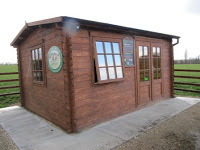 I'd seen the signs advertising milk on the roads leading to Southwell, in Nottinghamshire, but I've never investigated, until going yesterday with friends, who were well used to buying their milk this way. Following the signs from the B6386, you arrive at a small shed at the side of a field! However, inside is a revelation, containing not only spotless bottles (both plastic and glass), but the small, neat vending machine.
I'd seen the signs advertising milk on the roads leading to Southwell, in Nottinghamshire, but I've never investigated, until going yesterday with friends, who were well used to buying their milk this way. Following the signs from the B6386, you arrive at a small shed at the side of a field! However, inside is a revelation, containing not only spotless bottles (both plastic and glass), but the small, neat vending machine.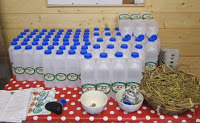
Fortunately the instructions are very clear and simple, and between bottles, the machine fills with steam. This is presumably some cleaning mechanism, but gives it a wonderful Dr Who appearance!
 The interesting sheets pinned on the wall explain that the milk has been produced by approximately 350 pure bred Monteblellarde cows. These 'Montys' originate from France, and are a sturdier build than the more familiar black and white Holstein.
The interesting sheets pinned on the wall explain that the milk has been produced by approximately 350 pure bred Monteblellarde cows. These 'Montys' originate from France, and are a sturdier build than the more familiar black and white Holstein.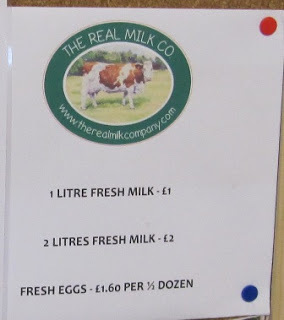 I was amused to read that the cow on their sign is a real one, called Valance, and was one of the first the farm imported back in 2010. Monty milk is usually higher in constituents (proteins, butterfats etc) than Holstein milk, so it makes excellent yogurt and cheese.
I was amused to read that the cow on their sign is a real one, called Valance, and was one of the first the farm imported back in 2010. Monty milk is usually higher in constituents (proteins, butterfats etc) than Holstein milk, so it makes excellent yogurt and cheese.The herd is milked once a day (startmg at 5.30am), and as well as supplying the milk shed, some goes to Arla, and ends up in supermarkets.
What I particularly liked was the fact that there seems to be emphasis on keeping the cows happy, believing,
probably rightly, that they are healthier. From March til the end of October they graze outside, and only come into the warm barn when the weather turns inclement. There they have comfy straw bedding, and a hardstanding yard where they can still get some fresh air and feel the winter sun on their backs. During the winter months the cows are fed on a diet of grass silage and fodder beet and are given a small amount of concentrates (a pelleted feed which provides vitamins and minerals).
 I was pleased to read that this farm is free from any GM ingredients and in fact is currently converting to organic status - a lengthy process I believe. Currently no chemical sprays or artificial fertilisers are applied to any of their fields and pasture improvement is done using natural methods - such as using different plants in the seed mixtures, which is good for wildlife and the environment too.
I was pleased to read that this farm is free from any GM ingredients and in fact is currently converting to organic status - a lengthy process I believe. Currently no chemical sprays or artificial fertilisers are applied to any of their fields and pasture improvement is done using natural methods - such as using different plants in the seed mixtures, which is good for wildlife and the environment too.What is there not to like about this really excellent set-up? It certainly appealed to me, and I will definitely be back, hopefully when there are some eggs, which it appears can be different colours. Now that sounds irresistible to me!
I will certainly be a returning customer.
***
Did you know I now have a web page, showing all my books? Why not take a look by clicking here
Published on March 06, 2016 09:34
February 17, 2016
Bolham Manor - Open Garden - Nottinghamshire
I just love visiting gardens under the National Garden Scheme (see previous blog), but of course this is a treat usually reserved for the summer months.
Imagine my delight therefore when the local newspaper advertised a garden would be open to the public in February. I couldn't wait to go!
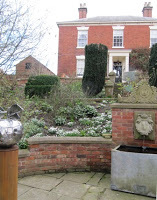 Bolham Manor is to the north west of Retford in north Nottinghamshire, and fortunately was very well signed, as it is somewhat off the beaten track. There was plenty of car parking some distance from the main dwelling, but also space nearer for the disabled.
Bolham Manor is to the north west of Retford in north Nottinghamshire, and fortunately was very well signed, as it is somewhat off the beaten track. There was plenty of car parking some distance from the main dwelling, but also space nearer for the disabled.
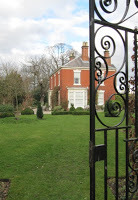 I started my day with a much-appreciated bowl of hot soup and a roll, and there were plenty of delicious-looking cakes on sale too - always an important part of a garden visit!
I started my day with a much-appreciated bowl of hot soup and a roll, and there were plenty of delicious-looking cakes on sale too - always an important part of a garden visit!
The House itself is an elegant 19th century Manor House set in three acres of beautiful gardens and grounds, and apparently is available for bed and breakfast, although I didn't see any signs to this effect.
The striking House is surrounded on two sides by lovely gardens, and sculptures, which I really enjoyed. There is a wide, paved terrace, and lawns.

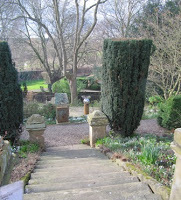 On the other side is a steep bank, not ideal for gardening, but here cleverly turned into a series of terraces, which were just full of snowdrops, hellebores and early daffodils. Just lovely. There are quite a lot of steep steps, but also smooth, sloping paths, so accessible by just about everyone. At the very bottom is a most attractive lake, and tucked away in the corner what looked to be an exciting cave.
On the other side is a steep bank, not ideal for gardening, but here cleverly turned into a series of terraces, which were just full of snowdrops, hellebores and early daffodils. Just lovely. There are quite a lot of steep steps, but also smooth, sloping paths, so accessible by just about everyone. At the very bottom is a most attractive lake, and tucked away in the corner what looked to be an exciting cave.
Beyond the House is a flat area where great clumps of crocuses and other spring flowers were a real delight.
I really enjoyed my visit to Bolham Manor, and was delighted to hear that it also opens in the summer when the roses are in flower. I'll certainly be going then!
***
Imagine my delight therefore when the local newspaper advertised a garden would be open to the public in February. I couldn't wait to go!
 Bolham Manor is to the north west of Retford in north Nottinghamshire, and fortunately was very well signed, as it is somewhat off the beaten track. There was plenty of car parking some distance from the main dwelling, but also space nearer for the disabled.
Bolham Manor is to the north west of Retford in north Nottinghamshire, and fortunately was very well signed, as it is somewhat off the beaten track. There was plenty of car parking some distance from the main dwelling, but also space nearer for the disabled. I started my day with a much-appreciated bowl of hot soup and a roll, and there were plenty of delicious-looking cakes on sale too - always an important part of a garden visit!
I started my day with a much-appreciated bowl of hot soup and a roll, and there were plenty of delicious-looking cakes on sale too - always an important part of a garden visit!The House itself is an elegant 19th century Manor House set in three acres of beautiful gardens and grounds, and apparently is available for bed and breakfast, although I didn't see any signs to this effect.
The striking House is surrounded on two sides by lovely gardens, and sculptures, which I really enjoyed. There is a wide, paved terrace, and lawns.

 On the other side is a steep bank, not ideal for gardening, but here cleverly turned into a series of terraces, which were just full of snowdrops, hellebores and early daffodils. Just lovely. There are quite a lot of steep steps, but also smooth, sloping paths, so accessible by just about everyone. At the very bottom is a most attractive lake, and tucked away in the corner what looked to be an exciting cave.
On the other side is a steep bank, not ideal for gardening, but here cleverly turned into a series of terraces, which were just full of snowdrops, hellebores and early daffodils. Just lovely. There are quite a lot of steep steps, but also smooth, sloping paths, so accessible by just about everyone. At the very bottom is a most attractive lake, and tucked away in the corner what looked to be an exciting cave.Beyond the House is a flat area where great clumps of crocuses and other spring flowers were a real delight.
I really enjoyed my visit to Bolham Manor, and was delighted to hear that it also opens in the summer when the roses are in flower. I'll certainly be going then!
***
Published on February 17, 2016 04:13
January 18, 2016
Machine Gun Corps exhibition - Belton House - Lincolnshire
There's a new exhibition at this lovely National Trust exhibition, and it's all about the Machine Gun Corps which was formed to provide a specialist training team. Members of the MCC were recruited from existing regiments, being singled out for their intelligence and physical strength, with excellent eyesight being crucial. During 1914 the 3rd Earl Brownlow offered Belton Park to the War Office.

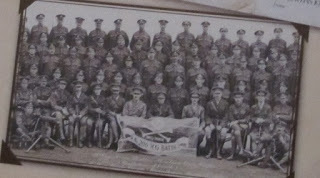 Somewhat disconcertingly, the gunners were known as The Suicide Club as their positions often stood out to the enemy, due to mist forming over their position which was caused by evaporation from their water cooled gun barrels. There was also apt to be a glow from their position at night due to their hot gun barrels, and as though that wasn't enough, sun reflecting off the mass of spent brass shells (up to 500 rounds per minute) gave away their position. Not surprisingly, front line soldiers soon learnt to stay well away from MCC positions!
Somewhat disconcertingly, the gunners were known as The Suicide Club as their positions often stood out to the enemy, due to mist forming over their position which was caused by evaporation from their water cooled gun barrels. There was also apt to be a glow from their position at night due to their hot gun barrels, and as though that wasn't enough, sun reflecting off the mass of spent brass shells (up to 500 rounds per minute) gave away their position. Not surprisingly, front line soldiers soon learnt to stay well away from MCC positions!
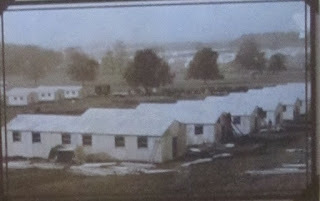 The camp layout at Belton must have been a sight to behold, for it became in essence a small town. Not only was their a Young Men's Christian Association hut, but a cinema and churches of various denominations. The men also had access to showers and foot baths, and everywhere was supplied with electricity.There was also an impressive Military Hospital with 550 beds, dentists surgery, x-ray facilities, a mortuary and an isolation hospital. Each patient was given a hospital kit of a suit of blue serge clothes, two shirts, pair of socks, handkerchief, pillowslip, towel and a pair of shoes, plus a knife, fork and spoon, bread and butter dish, a mug and plate. The hospital also got regular donations of food and local people started an egg collection in early 1916, bringing in around 220 eggs each week.
The camp layout at Belton must have been a sight to behold, for it became in essence a small town. Not only was their a Young Men's Christian Association hut, but a cinema and churches of various denominations. The men also had access to showers and foot baths, and everywhere was supplied with electricity.There was also an impressive Military Hospital with 550 beds, dentists surgery, x-ray facilities, a mortuary and an isolation hospital. Each patient was given a hospital kit of a suit of blue serge clothes, two shirts, pair of socks, handkerchief, pillowslip, towel and a pair of shoes, plus a knife, fork and spoon, bread and butter dish, a mug and plate. The hospital also got regular donations of food and local people started an egg collection in early 1916, bringing in around 220 eggs each week.
 This panel particularly made me laugh. Washing 18,000 articles of men's clothing was a real problem until some patriotic local ladies intervened. They devised a scheme to pay local women 3½d (about £1.05 today) for washing one man's set of clothing. The women were allocated 24 sets and so received 7 shillings (£24.47 today) from the Grantham War Distress Committee which was reimbursed by the military authorities. However, the scheme didn't start well with 168 articles being lost in transit and complaints of clothing coming back freshly infected with lice.
This panel particularly made me laugh. Washing 18,000 articles of men's clothing was a real problem until some patriotic local ladies intervened. They devised a scheme to pay local women 3½d (about £1.05 today) for washing one man's set of clothing. The women were allocated 24 sets and so received 7 shillings (£24.47 today) from the Grantham War Distress Committee which was reimbursed by the military authorities. However, the scheme didn't start well with 168 articles being lost in transit and complaints of clothing coming back freshly infected with lice.
The most shocking panel was the last one which stated that "At 11am on 11 November 1918, over 5 years since it began, the First World War came to an end. Approximately 8.5 million British men had been mobilised, over 2 million were wounded and almost 1 million never returned home to their families. Amongst these were 14,500 men who had trained on Belton Park before going out to the frontlines, never to return home."
This fascinating, well-constructed exhibition was in the stable block, beyond the book sales area. I think there were other things associated with the Gunners, but this was all I had time to see, and I thought it really interesting. Well worth a visit. ***
Are you familiar with the Clumber Love Story? If not here's my FREE e-book
n.

 Somewhat disconcertingly, the gunners were known as The Suicide Club as their positions often stood out to the enemy, due to mist forming over their position which was caused by evaporation from their water cooled gun barrels. There was also apt to be a glow from their position at night due to their hot gun barrels, and as though that wasn't enough, sun reflecting off the mass of spent brass shells (up to 500 rounds per minute) gave away their position. Not surprisingly, front line soldiers soon learnt to stay well away from MCC positions!
Somewhat disconcertingly, the gunners were known as The Suicide Club as their positions often stood out to the enemy, due to mist forming over their position which was caused by evaporation from their water cooled gun barrels. There was also apt to be a glow from their position at night due to their hot gun barrels, and as though that wasn't enough, sun reflecting off the mass of spent brass shells (up to 500 rounds per minute) gave away their position. Not surprisingly, front line soldiers soon learnt to stay well away from MCC positions! The camp layout at Belton must have been a sight to behold, for it became in essence a small town. Not only was their a Young Men's Christian Association hut, but a cinema and churches of various denominations. The men also had access to showers and foot baths, and everywhere was supplied with electricity.There was also an impressive Military Hospital with 550 beds, dentists surgery, x-ray facilities, a mortuary and an isolation hospital. Each patient was given a hospital kit of a suit of blue serge clothes, two shirts, pair of socks, handkerchief, pillowslip, towel and a pair of shoes, plus a knife, fork and spoon, bread and butter dish, a mug and plate. The hospital also got regular donations of food and local people started an egg collection in early 1916, bringing in around 220 eggs each week.
The camp layout at Belton must have been a sight to behold, for it became in essence a small town. Not only was their a Young Men's Christian Association hut, but a cinema and churches of various denominations. The men also had access to showers and foot baths, and everywhere was supplied with electricity.There was also an impressive Military Hospital with 550 beds, dentists surgery, x-ray facilities, a mortuary and an isolation hospital. Each patient was given a hospital kit of a suit of blue serge clothes, two shirts, pair of socks, handkerchief, pillowslip, towel and a pair of shoes, plus a knife, fork and spoon, bread and butter dish, a mug and plate. The hospital also got regular donations of food and local people started an egg collection in early 1916, bringing in around 220 eggs each week.
 This panel particularly made me laugh. Washing 18,000 articles of men's clothing was a real problem until some patriotic local ladies intervened. They devised a scheme to pay local women 3½d (about £1.05 today) for washing one man's set of clothing. The women were allocated 24 sets and so received 7 shillings (£24.47 today) from the Grantham War Distress Committee which was reimbursed by the military authorities. However, the scheme didn't start well with 168 articles being lost in transit and complaints of clothing coming back freshly infected with lice.
This panel particularly made me laugh. Washing 18,000 articles of men's clothing was a real problem until some patriotic local ladies intervened. They devised a scheme to pay local women 3½d (about £1.05 today) for washing one man's set of clothing. The women were allocated 24 sets and so received 7 shillings (£24.47 today) from the Grantham War Distress Committee which was reimbursed by the military authorities. However, the scheme didn't start well with 168 articles being lost in transit and complaints of clothing coming back freshly infected with lice.The most shocking panel was the last one which stated that "At 11am on 11 November 1918, over 5 years since it began, the First World War came to an end. Approximately 8.5 million British men had been mobilised, over 2 million were wounded and almost 1 million never returned home to their families. Amongst these were 14,500 men who had trained on Belton Park before going out to the frontlines, never to return home."
This fascinating, well-constructed exhibition was in the stable block, beyond the book sales area. I think there were other things associated with the Gunners, but this was all I had time to see, and I thought it really interesting. Well worth a visit. ***
Are you familiar with the Clumber Love Story? If not here's my FREE e-book
n.
Published on January 18, 2016 04:14
December 22, 2015
Chatsworth - Christmas with Mr Toad - Derbyshire
Visiting Chatsworth to see their decorations is definitely part of the season's celebrations for me, and I always really look forward to the event.
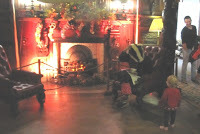 This year it was 'Christmas at Chatsworth with Mr Toad', which had been inspired by Kenneth Grahame's classic 'The Wind in the Willows'. Many of the rooms were decorated to show the theme, and I particularly liked Badger's Kitchen, where he was sitting by the fire and greeting everyone most warmly!
This year it was 'Christmas at Chatsworth with Mr Toad', which had been inspired by Kenneth Grahame's classic 'The Wind in the Willows'. Many of the rooms were decorated to show the theme, and I particularly liked Badger's Kitchen, where he was sitting by the fire and greeting everyone most warmly!
Upstairs Mole was snoring soundly in a little bed, whilst Ratty was taking a bath! Quite irresistible!
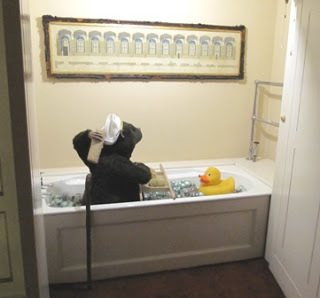

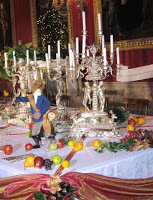 A highlight is always the changing face of the beautiful Dining Room, but with Toad gone the weasels had taken over Toad Hall and driven Ratty, Mole and Badger out! They were even throwing a party for the Chief weasel's birthday!
A highlight is always the changing face of the beautiful Dining Room, but with Toad gone the weasels had taken over Toad Hall and driven Ratty, Mole and Badger out! They were even throwing a party for the Chief weasel's birthday!
The finale was in the Sculpture Gallery where Toad glowed with happiness.
I must admit I did not think this was one of Chatsworth's best Christmas decorations, having enjoyed previous years more, but I think that partly because I was not that familiar with the story. I was given a small booklet to explain each room, but I think, like most people, I read it after I got home!
 However, I did enjoy all the splendidly lit Christmas trees, of which there were many, both inside and out.
However, I did enjoy all the splendidly lit Christmas trees, of which there were many, both inside and out.
However, I still think I enjoyed Tissington Hall the best this Christmas (see previous blog)
***
 This year it was 'Christmas at Chatsworth with Mr Toad', which had been inspired by Kenneth Grahame's classic 'The Wind in the Willows'. Many of the rooms were decorated to show the theme, and I particularly liked Badger's Kitchen, where he was sitting by the fire and greeting everyone most warmly!
This year it was 'Christmas at Chatsworth with Mr Toad', which had been inspired by Kenneth Grahame's classic 'The Wind in the Willows'. Many of the rooms were decorated to show the theme, and I particularly liked Badger's Kitchen, where he was sitting by the fire and greeting everyone most warmly!Upstairs Mole was snoring soundly in a little bed, whilst Ratty was taking a bath! Quite irresistible!


 A highlight is always the changing face of the beautiful Dining Room, but with Toad gone the weasels had taken over Toad Hall and driven Ratty, Mole and Badger out! They were even throwing a party for the Chief weasel's birthday!
A highlight is always the changing face of the beautiful Dining Room, but with Toad gone the weasels had taken over Toad Hall and driven Ratty, Mole and Badger out! They were even throwing a party for the Chief weasel's birthday!The finale was in the Sculpture Gallery where Toad glowed with happiness.
I must admit I did not think this was one of Chatsworth's best Christmas decorations, having enjoyed previous years more, but I think that partly because I was not that familiar with the story. I was given a small booklet to explain each room, but I think, like most people, I read it after I got home!
 However, I did enjoy all the splendidly lit Christmas trees, of which there were many, both inside and out.
However, I did enjoy all the splendidly lit Christmas trees, of which there were many, both inside and out.However, I still think I enjoyed Tissington Hall the best this Christmas (see previous blog)
***
Published on December 22, 2015 02:45
December 7, 2015
Music & Carols - Milton Mausoleum - Nottinghamshire
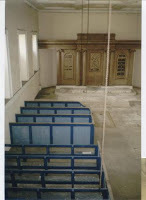
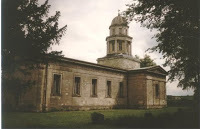 I've known this little building for decades, and it's history is described in my e-book The Clumber Love Story. It became so sad, rarely open to the public, dark and dismal and not somewhere you'd want to visit.
I've known this little building for decades, and it's history is described in my e-book The Clumber Love Story. It became so sad, rarely open to the public, dark and dismal and not somewhere you'd want to visit.However, all that changed in May this year when a 'Friends of the Mausoleum' group was formed, and after a successful first season they were now planning a special Christmas event, and I couldn't wait to attend!
What a sight greeted me! Not only were people pouring in, but every available windowsill was decorated, there were two sparkling Christmas trees, and refreshments, raffle tickets and Christmas cards were all on sale. Then it was time for the concert.
It began with the Wales Methodist Pantomime Players, who are actually I believe are based just outside Sheffield, giving an enthusiastic collections of songs, ranging from traditional Christmas carols to this rather lovely cappella.
Then a gentleman called Mick Parkes and his daughter Lydia walked down the central aisle, playing the bagpipes - a real surprise!
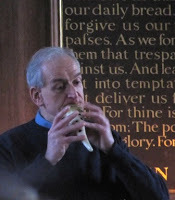 This gentleman was so talented and it was incredible Here he's playing beautiful music on what appeared to be an old cow horn! And not only did he play, but gave the most interesting details of each old instrument.
This gentleman was so talented and it was incredible Here he's playing beautiful music on what appeared to be an old cow horn! And not only did he play, but gave the most interesting details of each old instrument.The afternoon ended with a few traditional carols which the packed congregation enthusiastically joined in, and the wonderful afternoon ended with all the volunteers going to the front. There they sang 'We wish you a Merry Christmas and a Happy New Year', with the congregation quickly joining in, and sending it back to them, which I thought was lovely.
It was hard to believe that it was 1946 when the last Carol Service took place in this building, but I have a feeling that this could be the start of an annual, much-anticipated event. I certainly wish the enthusiastic group of volunteers every success in the future, and look forward to attending further events.
If you are ever in the area, there will be Guides available every Sunday afternoon from May til September.during 2016.*** Did you know I now have a web page? Why not take a look by clicking here
This gentlemand
Published on December 07, 2015 01:59
November 24, 2015
'What the Dickens?!' - Tissington Hall - Derbyshire
 It was many years since I last visited Tissington Hall, and seeing there was something special taking place I decided it was time for a trip through the stunning Derbyshire countryside to this private, gated estate.
It was many years since I last visited Tissington Hall, and seeing there was something special taking place I decided it was time for a trip through the stunning Derbyshire countryside to this private, gated estate.The poster said 'Walk the hallways of this historic house, decked in Dickensian Christmas style. Follow in the footsteps of Dickens greatest characters and witness scenes from his best known works' and that was exactly what I did.
 The Main Hall had been transformed in the Gragery's Parlour, as vividly described in 'Great Expectations'. I particularly liked the tempting slices of pie lying on each plate and the board read '...I heard Mr. Hubble remark that "a bit of savoury pork pie would lay atop of anything you could mention, and do no harm'. What immediately struck me was the incredible trouble that had been taken to get every detail correct, like here every place setting had a handwritten name tag. Clearly this was going to be a fun event!
The Main Hall had been transformed in the Gragery's Parlour, as vividly described in 'Great Expectations'. I particularly liked the tempting slices of pie lying on each plate and the board read '...I heard Mr. Hubble remark that "a bit of savoury pork pie would lay atop of anything you could mention, and do no harm'. What immediately struck me was the incredible trouble that had been taken to get every detail correct, like here every place setting had a handwritten name tag. Clearly this was going to be a fun event!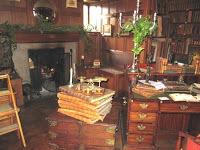
Then it was upstairs to visit Mr Tulkinghorn's Law Offices as described in 'Bleak House'. I could have spent hours in this fascinating space there was just so much to see and marvel at!
But Miss Haversham's Wedding Table in Satis House was waiting! The Information Board reminded us that 'It was spacious, and I dare say had once been handsome, but every discernible thing in it was covered with dust and mould, and dropping to pieces. The most prominent object was a table with a long tablecloth spread on it, as if a feast had been in preparation when the house and the clocks stopped all together.' Creepy or what - but quite marvellous!

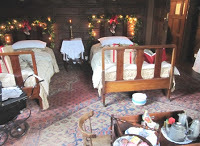 Another, much more cheerful room was the Narnia Room, based on Stories for the Christmas Fire - a collection by Charles Dickens and it appeared a Mrs E Gaskell, which was certainly new to me. The board said "There was an old nursery, that had been used for all the little lords and ladies long ago, with a pleasant fire burning in the grate, and the kettle boiling on the bob, and tea things spread out on the table."
Another, much more cheerful room was the Narnia Room, based on Stories for the Christmas Fire - a collection by Charles Dickens and it appeared a Mrs E Gaskell, which was certainly new to me. The board said "There was an old nursery, that had been used for all the little lords and ladies long ago, with a pleasant fire burning in the grate, and the kettle boiling on the bob, and tea things spread out on the table."There were a few more rooms than I have described, but what completed my visit was walking over to the wonderful Edward and Vintage Shop which I just love visiting it's so special and unique (see previous blog). It was the lovely David who had been responsible for the event at Tissington Hall and it was so interesting talking to him. For example when he and a helper went into the cellar to collect some bottles of wine to go onto Miss Haversham's wedding table, he suggested that they hold them at the base and walk through the cellar carrying them high above their heads so they would catch any cobwebs! In fact he was full of such fascinating details it really made the visit even more special for me, and I'm so glad that he's already full of ideas for next year, when it will be even bigger and better.
I for one can't wait!!
***Can I ask you a favour please? Could you take a look at my novel which I've written solely to raise funds for Lepra, the wonderful charity that helps people with leprosy. It's called 'Every 2 Minutes' - because that is the frequency someone, today, has been diagnosed with this totally curable disease. Just click here for Amazon and here for Smashwords. Thank you so much
Published on November 24, 2015 11:14
October 25, 2015
Lady Spencer's Walk - Hardwick Hall - Derbyshire
I've been to lovely Hardwick Hall many times, not least because they sell my booklet about tragic Arbella Stuart in their shop (for the e-book just click here). However, I had never followed the signs in the car park and explored Lady Spencer's Walk
.
Lady Margaret Georgiana Spencer married John, the 1st Earl Spencer of Althrop (so an ancestor to Princess Diana) and they had five daughters.
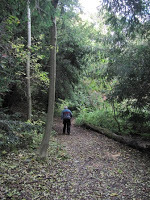 Georgiana was one of their daughters, and when she married William Cavendish (5th Duke of Devonshire) in 1771 this linked the Spencer family back 8 generations to Bess of Hardwick.
Georgiana was one of their daughters, and when she married William Cavendish (5th Duke of Devonshire) in 1771 this linked the Spencer family back 8 generations to Bess of Hardwick.
Lady Spencer loved the countryside and had a passion for gardens, something that led her to create this special walk.
Whilst staying at Hardwick with her daughter, Lady Spencer instigated the development of this woodland walk Harriet, the daughter of the 5th Duke of Devonshire and Georgiana, wrote to her governess Selina: 'Yesterday my grandmamma and I had been employed all the morning amusing ourselves with cutting a walk through a plantation ... you cannot think how pretty it will be when it is covered with gravel'
Originally this was quite a short walk but in the early 19th century it was extended. Historically the weeding and general maintenance of Lady Spencer's Walk was one of the gardener's regular duties until the upheaval caused by World War I. Since then the wood has been allowed to return to its natural state, but that is not a bad thing, and the wildlife must flourish here. In the springtime an information board states that there are wood violets, wild daffodils and wild arum (commonly known as lords and ladies).
Lady Spencer's Walk is the only mature beech woodland on the Hardwick estate and is home to many birds including the tree creeper, nuthatch and green woodpecker.
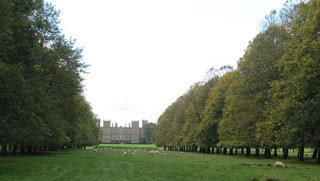 The path also leads across the famous 'Wine Glass' formation of trees, which unfortunately is very difficult to photograph adequately as it is so large! This is part of the stem of the glass, looking back at Hardwick Hall.
The path also leads across the famous 'Wine Glass' formation of trees, which unfortunately is very difficult to photograph adequately as it is so large! This is part of the stem of the glass, looking back at Hardwick Hall.
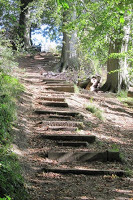
I loved this wood, although there are quite a lot of steps as the land is quite undulating, so is unsuitable for wheelchairs and maybe pushchairs.
***
I've now got a web page! Why not take a look by clicking here
.
Lady Margaret Georgiana Spencer married John, the 1st Earl Spencer of Althrop (so an ancestor to Princess Diana) and they had five daughters.
 Georgiana was one of their daughters, and when she married William Cavendish (5th Duke of Devonshire) in 1771 this linked the Spencer family back 8 generations to Bess of Hardwick.
Georgiana was one of their daughters, and when she married William Cavendish (5th Duke of Devonshire) in 1771 this linked the Spencer family back 8 generations to Bess of Hardwick.Lady Spencer loved the countryside and had a passion for gardens, something that led her to create this special walk.
Whilst staying at Hardwick with her daughter, Lady Spencer instigated the development of this woodland walk Harriet, the daughter of the 5th Duke of Devonshire and Georgiana, wrote to her governess Selina: 'Yesterday my grandmamma and I had been employed all the morning amusing ourselves with cutting a walk through a plantation ... you cannot think how pretty it will be when it is covered with gravel'
Originally this was quite a short walk but in the early 19th century it was extended. Historically the weeding and general maintenance of Lady Spencer's Walk was one of the gardener's regular duties until the upheaval caused by World War I. Since then the wood has been allowed to return to its natural state, but that is not a bad thing, and the wildlife must flourish here. In the springtime an information board states that there are wood violets, wild daffodils and wild arum (commonly known as lords and ladies).
Lady Spencer's Walk is the only mature beech woodland on the Hardwick estate and is home to many birds including the tree creeper, nuthatch and green woodpecker.
 The path also leads across the famous 'Wine Glass' formation of trees, which unfortunately is very difficult to photograph adequately as it is so large! This is part of the stem of the glass, looking back at Hardwick Hall.
The path also leads across the famous 'Wine Glass' formation of trees, which unfortunately is very difficult to photograph adequately as it is so large! This is part of the stem of the glass, looking back at Hardwick Hall.
I loved this wood, although there are quite a lot of steps as the land is quite undulating, so is unsuitable for wheelchairs and maybe pushchairs.
***
I've now got a web page! Why not take a look by clicking here
Published on October 25, 2015 00:15
October 15, 2015
Osberton International Horse Trials 2015 - Worksop - north Nottinghamshire
Osberton is an absolutely vast, beautiful country estate just outside Worksop. Normally it is very private and inaccessible, so any chance to get inside is well worth taking!
The entry price was £15 each, with no concessions, which with the programme as well, was going to make for a pretty pricey day, so I was just wondering if it was going to be worth it.
However, it soon became clear that this was a really big event - in fact I have never seen so many well-groomed horses and immaculate riders in one place before - there must have been hundreds taking part!
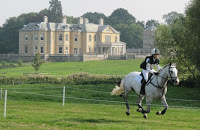
I was immediately attracted to the Cross Country, which is so spectacular, especially on such a lovely estate.
Then it was just a case of walking over to see the water splash - such fun!
Then it was back to the arenas were so much was going on it was hard to decide what to watch! This is the Dog Agility competition, which did seem somewhat manic to me! What was amazing was the fact that competitors had come from all round the country, and yet were disqualified within seconds! They then continued to complete the course because the commentator said, the dog didn't realise that it had made a mistake! Certainly something new for me to watch!
There was also a display by the Vale of York Polo Display with a really interesting commentary. I never knew that you had to hold the mallet in your right hand, so tough luck if you are left-handed like Prince William!
Then there was the Driving Display, always good to watch, and again with a really excellent commentary - this makes such a difference.
Altogether this was a brilliant day out, helped by perfect weather and superb organisation. I look forward to going again next year.

***I now have a web page! Why not take a look by clicking here ;
The entry price was £15 each, with no concessions, which with the programme as well, was going to make for a pretty pricey day, so I was just wondering if it was going to be worth it.
However, it soon became clear that this was a really big event - in fact I have never seen so many well-groomed horses and immaculate riders in one place before - there must have been hundreds taking part!

I was immediately attracted to the Cross Country, which is so spectacular, especially on such a lovely estate.
Then it was just a case of walking over to see the water splash - such fun!
Then it was back to the arenas were so much was going on it was hard to decide what to watch! This is the Dog Agility competition, which did seem somewhat manic to me! What was amazing was the fact that competitors had come from all round the country, and yet were disqualified within seconds! They then continued to complete the course because the commentator said, the dog didn't realise that it had made a mistake! Certainly something new for me to watch!
There was also a display by the Vale of York Polo Display with a really interesting commentary. I never knew that you had to hold the mallet in your right hand, so tough luck if you are left-handed like Prince William!
Then there was the Driving Display, always good to watch, and again with a really excellent commentary - this makes such a difference.
Altogether this was a brilliant day out, helped by perfect weather and superb organisation. I look forward to going again next year.

***I now have a web page! Why not take a look by clicking here ;
Published on October 15, 2015 02:48
October 1, 2015
Southwell Ploughing Match & Show 2015 - Oxton - Nottinghamshire
I really enjoy this annual horticultural show, but last year the traffic congestion was so bad I really was unsure whether to attend this year. However, with a different location I decided to risk it, and I was so glad I did, for this time the traffic flow was much better organised and I arrived and parked quickly and hassle-free.
 This is a show with literally something for everyone. I always start by going on a tractor ride as this gives a good idea of the general layout of the Show, and I can decide where to go first! It would have been good if there had been more tractors going round as there were long queue for this very popular ride, and I know there are these vehicles available from the excellent annual Perlethorpe Ride (see previous blog)
This is a show with literally something for everyone. I always start by going on a tractor ride as this gives a good idea of the general layout of the Show, and I can decide where to go first! It would have been good if there had been more tractors going round as there were long queue for this very popular ride, and I know there are these vehicles available from the excellent annual Perlethorpe Ride (see previous blog)
 I then headed over to the cattle area and saw the biggest bull I think I've ever seen. Good job it was so good natured as you'd never be able to handle it otherwise!
I then headed over to the cattle area and saw the biggest bull I think I've ever seen. Good job it was so good natured as you'd never be able to handle it otherwise!
Of course there is a vast area with every type of ploughing going on, from steam-driven machines to horses and huge modern machines. You could easily spend the whole day just going round the area
watching.
The arena had the most marvellous selection of entertainment going on continuously. A particularly popular one was the parade of hounds. At one point all the children were invited into the ring to pet the dogs - and how popular that was! They are clearly very good natured and enjoyed all the fuss. What always amazes me is that the huntsman knows the names of the all the dogs - they mostly look the same to me!
 Undoubtedly the most popular event in the arena was the return of the Digger Dance. It was years since I'd last seen this demonstration but it was as good as ever. What I like is the fact that they are just ordinary JCB's that work out on the roads all the week, and then come Friday night they go back to the yard for a wash and brush-up, before heading out on Saturday to entertain at the shows. I took a load of videos so you can see more of their performance by clicking here
Undoubtedly the most popular event in the arena was the return of the Digger Dance. It was years since I'd last seen this demonstration but it was as good as ever. What I like is the fact that they are just ordinary JCB's that work out on the roads all the week, and then come Friday night they go back to the yard for a wash and brush-up, before heading out on Saturday to entertain at the shows. I took a load of videos so you can see more of their performance by clicking here
Altogether it was a grand day out, helped by perfect weather and good organisation. I shall certainly be attending next year.
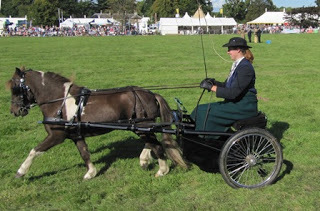 ***I.ve a new Web Page! Why not take a look by clicking here
***I.ve a new Web Page! Why not take a look by clicking here
 This is a show with literally something for everyone. I always start by going on a tractor ride as this gives a good idea of the general layout of the Show, and I can decide where to go first! It would have been good if there had been more tractors going round as there were long queue for this very popular ride, and I know there are these vehicles available from the excellent annual Perlethorpe Ride (see previous blog)
This is a show with literally something for everyone. I always start by going on a tractor ride as this gives a good idea of the general layout of the Show, and I can decide where to go first! It would have been good if there had been more tractors going round as there were long queue for this very popular ride, and I know there are these vehicles available from the excellent annual Perlethorpe Ride (see previous blog) I then headed over to the cattle area and saw the biggest bull I think I've ever seen. Good job it was so good natured as you'd never be able to handle it otherwise!
I then headed over to the cattle area and saw the biggest bull I think I've ever seen. Good job it was so good natured as you'd never be able to handle it otherwise!Of course there is a vast area with every type of ploughing going on, from steam-driven machines to horses and huge modern machines. You could easily spend the whole day just going round the area
watching.
The arena had the most marvellous selection of entertainment going on continuously. A particularly popular one was the parade of hounds. At one point all the children were invited into the ring to pet the dogs - and how popular that was! They are clearly very good natured and enjoyed all the fuss. What always amazes me is that the huntsman knows the names of the all the dogs - they mostly look the same to me!
 Undoubtedly the most popular event in the arena was the return of the Digger Dance. It was years since I'd last seen this demonstration but it was as good as ever. What I like is the fact that they are just ordinary JCB's that work out on the roads all the week, and then come Friday night they go back to the yard for a wash and brush-up, before heading out on Saturday to entertain at the shows. I took a load of videos so you can see more of their performance by clicking here
Undoubtedly the most popular event in the arena was the return of the Digger Dance. It was years since I'd last seen this demonstration but it was as good as ever. What I like is the fact that they are just ordinary JCB's that work out on the roads all the week, and then come Friday night they go back to the yard for a wash and brush-up, before heading out on Saturday to entertain at the shows. I took a load of videos so you can see more of their performance by clicking hereAltogether it was a grand day out, helped by perfect weather and good organisation. I shall certainly be attending next year.
 ***I.ve a new Web Page! Why not take a look by clicking here
***I.ve a new Web Page! Why not take a look by clicking here
Published on October 01, 2015 04:05
September 25, 2015
'Beyond Limits: The Landscape of British Sculpture 1950-2015' - Chatsworth House - Derbyshire.
I love this outdoor sculpture exhibition and 2015 is the 10th anniversary of Sotheby's annual exhibition in the garden of Chatsworth House. This year is the largest to date, with more than 30 monumental sculptures by leading British artists scattered across this special area.
I must admit that the vast majority of works were not to my taste, but then sculpture is very subjective. For this blog I've just chosen to illustrate it with the ones that particularly appealed to me. (As often as I can I try to include people in my photos, so as to give a size perception to the sculptures.)
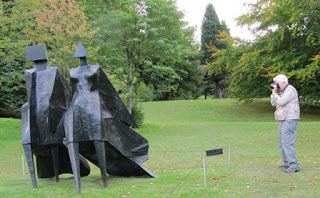 One of the first I came across was this 'Pair of Walking Figures - Jubilee' by Lynn Chadwick, which was conceived in 1977 and cast in bronze in an edition of 6. The stately figures stride confidently towards Chatsworth House, and although cast in heavy metal their clothes swirl as they move - I just love that! In the 1970s Chadwick conceived a simple, yet striking distinction between his male and female figures. Men were depicted with rectangular heads, whilst women were endowed with triangular ones.
One of the first I came across was this 'Pair of Walking Figures - Jubilee' by Lynn Chadwick, which was conceived in 1977 and cast in bronze in an edition of 6. The stately figures stride confidently towards Chatsworth House, and although cast in heavy metal their clothes swirl as they move - I just love that! In the 1970s Chadwick conceived a simple, yet striking distinction between his male and female figures. Men were depicted with rectangular heads, whilst women were endowed with triangular ones.
 Dame Barbara Hepworth was represented with several sculptures, which I must admit I do enjoy. This one,'Three Obliques (Walk In)' was, like all the other sculptures in this exhibition so well, and thoughtfully placed. It was cast in bronze in 1970 and is considered one of the artist's most impressive works and represents a significant shift in her approach to the 'Square Form' and architectural scale
Dame Barbara Hepworth was represented with several sculptures, which I must admit I do enjoy. This one,'Three Obliques (Walk In)' was, like all the other sculptures in this exhibition so well, and thoughtfully placed. It was cast in bronze in 1970 and is considered one of the artist's most impressive works and represents a significant shift in her approach to the 'Square Form' and architectural scale
 . Of course no exhibition of this sort would be complete without something by Sir Antony Gormley and this one is titled 'Big Gauge II'. The information board states 'In the complex interrelation between the blocks that comprise Big Gauge II, the artist turns the gaze inwards, exploring and exposing the body as a 'place' and 'site' within its own right: the site for the self.'
. Of course no exhibition of this sort would be complete without something by Sir Antony Gormley and this one is titled 'Big Gauge II'. The information board states 'In the complex interrelation between the blocks that comprise Big Gauge II, the artist turns the gaze inwards, exploring and exposing the body as a 'place' and 'site' within its own right: the site for the self.'
The sculpture placed at the very top of the famous cascade was entitled 'Guerrilla Gardener', by Simon Periton. It was executed in 2015 in painted steel and lacquer in an edition of 3 plus 1 artist's proof. It is a celebration of the humble leaf, here elevated and enlarged to a human scale. The brilliantly glowing colours dramatically define the structure of the leaf. I thought I was particularly fortunate that it was such a lovely day when I visited and the sunshine really made this installation glisten.
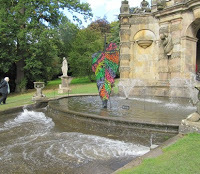
So what was my favourite in the whole exhibition? It has to be 'Sea Form (Atlantic' by Dame Barbara Hepworth, which was cast in bronze between 1964 and 1966. Hepworth drew inspiration from the landscape surrounding her St Ives' home and created sculptures such as this that directly engage with the environment in which they are set. The basic form derives in part from the Neolithic standing stones at the Chun Castle hill fort site in West Cornwall, and the ovoid piercings relate to the caves found along the Cornish coastline.
 I thought it just lovely, and knew it would look great standing in my garden, with the sun moving round and changing the effect every hour. Well. everyone can dream!
I thought it just lovely, and knew it would look great standing in my garden, with the sun moving round and changing the effect every hour. Well. everyone can dream!
***I've a new Web Page - why not take a look by clicking here
I must admit that the vast majority of works were not to my taste, but then sculpture is very subjective. For this blog I've just chosen to illustrate it with the ones that particularly appealed to me. (As often as I can I try to include people in my photos, so as to give a size perception to the sculptures.)
 One of the first I came across was this 'Pair of Walking Figures - Jubilee' by Lynn Chadwick, which was conceived in 1977 and cast in bronze in an edition of 6. The stately figures stride confidently towards Chatsworth House, and although cast in heavy metal their clothes swirl as they move - I just love that! In the 1970s Chadwick conceived a simple, yet striking distinction between his male and female figures. Men were depicted with rectangular heads, whilst women were endowed with triangular ones.
One of the first I came across was this 'Pair of Walking Figures - Jubilee' by Lynn Chadwick, which was conceived in 1977 and cast in bronze in an edition of 6. The stately figures stride confidently towards Chatsworth House, and although cast in heavy metal their clothes swirl as they move - I just love that! In the 1970s Chadwick conceived a simple, yet striking distinction between his male and female figures. Men were depicted with rectangular heads, whilst women were endowed with triangular ones. Dame Barbara Hepworth was represented with several sculptures, which I must admit I do enjoy. This one,'Three Obliques (Walk In)' was, like all the other sculptures in this exhibition so well, and thoughtfully placed. It was cast in bronze in 1970 and is considered one of the artist's most impressive works and represents a significant shift in her approach to the 'Square Form' and architectural scale
Dame Barbara Hepworth was represented with several sculptures, which I must admit I do enjoy. This one,'Three Obliques (Walk In)' was, like all the other sculptures in this exhibition so well, and thoughtfully placed. It was cast in bronze in 1970 and is considered one of the artist's most impressive works and represents a significant shift in her approach to the 'Square Form' and architectural scale . Of course no exhibition of this sort would be complete without something by Sir Antony Gormley and this one is titled 'Big Gauge II'. The information board states 'In the complex interrelation between the blocks that comprise Big Gauge II, the artist turns the gaze inwards, exploring and exposing the body as a 'place' and 'site' within its own right: the site for the self.'
. Of course no exhibition of this sort would be complete without something by Sir Antony Gormley and this one is titled 'Big Gauge II'. The information board states 'In the complex interrelation between the blocks that comprise Big Gauge II, the artist turns the gaze inwards, exploring and exposing the body as a 'place' and 'site' within its own right: the site for the self.'The sculpture placed at the very top of the famous cascade was entitled 'Guerrilla Gardener', by Simon Periton. It was executed in 2015 in painted steel and lacquer in an edition of 3 plus 1 artist's proof. It is a celebration of the humble leaf, here elevated and enlarged to a human scale. The brilliantly glowing colours dramatically define the structure of the leaf. I thought I was particularly fortunate that it was such a lovely day when I visited and the sunshine really made this installation glisten.

So what was my favourite in the whole exhibition? It has to be 'Sea Form (Atlantic' by Dame Barbara Hepworth, which was cast in bronze between 1964 and 1966. Hepworth drew inspiration from the landscape surrounding her St Ives' home and created sculptures such as this that directly engage with the environment in which they are set. The basic form derives in part from the Neolithic standing stones at the Chun Castle hill fort site in West Cornwall, and the ovoid piercings relate to the caves found along the Cornish coastline.
 I thought it just lovely, and knew it would look great standing in my garden, with the sun moving round and changing the effect every hour. Well. everyone can dream!
I thought it just lovely, and knew it would look great standing in my garden, with the sun moving round and changing the effect every hour. Well. everyone can dream!***I've a new Web Page - why not take a look by clicking here
Published on September 25, 2015 03:03



